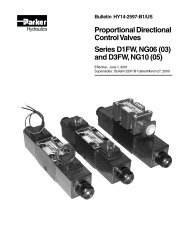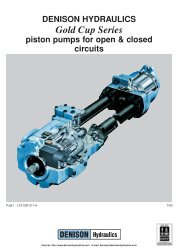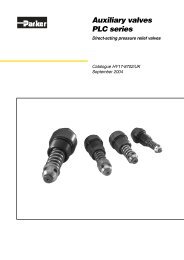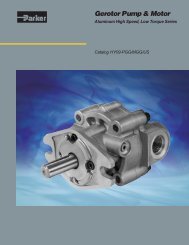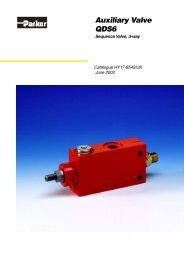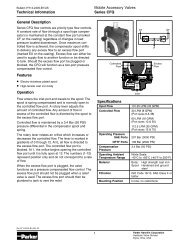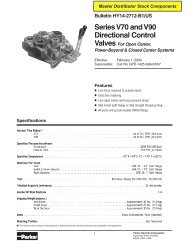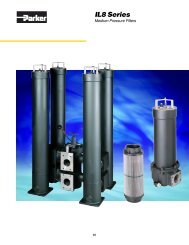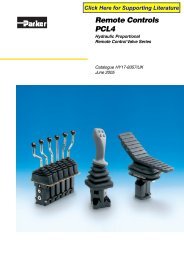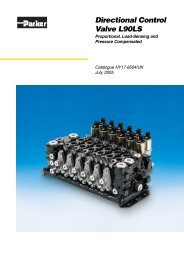Directional Control Valve P70 - Oleosistemas
Directional Control Valve P70 - Oleosistemas
Directional Control Valve P70 - Oleosistemas
You also want an ePaper? Increase the reach of your titles
YUMPU automatically turns print PDFs into web optimized ePapers that Google loves.
Catalogue HY17-8546/UK<br />
System description<br />
<strong>Directional</strong> <strong>Control</strong> <strong>Valve</strong>s<br />
<strong>P70</strong><br />
B<br />
A<br />
PF<br />
PS<br />
P2<br />
T4<br />
P1<br />
T1<br />
UL<br />
T2B<br />
T3B<br />
TPB<br />
Principle circuit diagram for valve with closed centre<br />
q(l/min)<br />
Flow rate in work port<br />
Constant-pressure systems, CP, CPU<br />
(<strong>Valve</strong> with closed centre, <strong>P70</strong>CP)<br />
Constant pressure systems are supplied by a variable displacement<br />
pump. This type of pump is controlled by a regulator which<br />
ensures that the pressure is kept constant whilst the flow varies<br />
to suit the demand. The constant-pressure system is of relatively<br />
simple construction, with an uncomplicated valve. However, the<br />
variable pump is more advanced than pumps with fixed displacement.<br />
To maintain the constant-pressure system’s superior control<br />
characteristics, the pump must be dimensioned to give the sum of<br />
the maximum flows for simultaneously operated functions. If the<br />
pressure cannot be maintained, the valve loses its control characteristics<br />
quickly and the actuated functions start to influence each<br />
other, with the lightest loads receiving the most oil. However, this<br />
system is less susceptible to pressure drops, as the pressure<br />
corresponding to the machine capacity is always available.<br />
There are two main types of pump on the market. What distinguishes<br />
them from each other is where the signal that influences<br />
the pump regulator comes from. One pump type takes the signal<br />
internally, whereas the other requires a signal from the directional<br />
valve. The <strong>P70</strong>CP can be used equally efficiently with either type.<br />
<strong>Control</strong> characteristics<br />
A correctly specified <strong>P70</strong>CP gives excellent control characteristics,<br />
with different functions having no affect upon each other. The<br />
system also has great anti cavitation characteristics which allow a<br />
lowering movement to change to a lifting one without delay.<br />
The maximum speed of each <strong>P70</strong>CP function is determined<br />
by the design of the spool and the pressure demands of the<br />
load. The <strong>P70</strong>CP can be fitted with a range of Parker’s specifically<br />
designed spools, allowing them to be exactly suited to the<br />
customers speed and function requirements. In the <strong>P70</strong>CP too,<br />
remote controlled spools are pressure compensated. However,<br />
if the flow requirements of the system exceed the maximum<br />
capacity of the pump, the pressure level cannot be maintained<br />
and the normally very good control characteristics deteriorate.<br />
80<br />
60<br />
40<br />
20<br />
0<br />
0<br />
150 bar lower<br />
100 bar<br />
50 bar<br />
50 bar lift<br />
150 bar<br />
20 40 60 80 100<br />
Lever stroke in %<br />
In the <strong>P70</strong>CP with hand-operated spools, all loads start moving<br />
at the same point, regardless of the size and direction of the load.<br />
The size of the load does, however, affect the slope of the curve<br />
to some extent.<br />
q(l/min)<br />
80<br />
60<br />
40<br />
20<br />
0<br />
0<br />
Flow rate in work port<br />
lift<br />
250 bar lower<br />
50 bar<br />
q pump<br />
20 40 60 80 100<br />
Lever stroke in %<br />
In the <strong>P70</strong>CP equipped with FPC, PC, ECS and ECH closed<br />
spool-actuators, the spools are pressure compensated, with the<br />
result that the load’s influence on speed is negligible.<br />
<br />
Parker Hannifin<br />
Mobile <strong>Control</strong>s Division Europe<br />
Borås, Sweden



